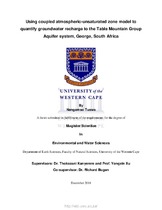| dc.contributor.advisor | Kanyerere, Thokozani | |
| dc.contributor.author | Tuswa, Nangamso | |
| dc.date.accessioned | 2019-10-02T11:47:21Z | |
| dc.date.available | 2019-10-02T11:47:21Z | |
| dc.date.issued | 2019 | |
| dc.identifier.uri | http://hdl.handle.net/11394/7059 | |
| dc.description | >Magister Scientiae - MSc | en_US |
| dc.description.abstract | The current study aimed at providing groundwater recharge estimates in a fractured rock aquifer environment that is occupied by pine plantation and indigenous forests in order to improve the understanding of the effect of pine plantation forests on recharge. This was based on the argument that for the trees to affect recharge, they do not necessarily need to tap directly from the saturated zone, as vegetation may indirectly affect groundwater recharge by interception and abstracting the infiltrating water in the vadose zone before reaching the water table. The study was conducted along the Southern Cape coastline of Western Cape Province in South Africa. This area is 7 km east of George in an area characterized by the occurrence of the Table Mountain Group aquifer. The research presented in this thesis formed part of a Water Research Commission (WRC) project titled “The Impacts of Commercial Plantation Forests on Groundwater Recharge and Streamflow”. To achieve the aim of the current study, three objectives were formulated: i) to characterize the dominantly occurring recharge mechanism ii) to determine long-term groundwater recharge estimates, and iii) to assess the effect of plantation forests on groundwater recharge. As part of characterizing the dominant recharge mechanism in the area, a conceptual groundwater recharge model of the area was developed to explain the recharge mechanism and facilitate an improved understanding of recharge estimates. The model was based on a theoretical understanding and previous investigations conducted in the study area. Methods such as environmental stable isotopes and hydrochemistry were used to refine the conceptual model by identifying the source of recharge and the dominant recharge mechanism. The occurrence and density of lineaments were used as a proxy to delineate potential recharge zones in the area. Recharge was estimated using the Rainfall Infiltration Breakthrough (RIB) and the Chloride Mass Balance (CMB) methods. Additionally, the effect of plantation forests on recharge was assessed using the HYDRUS-2D numerical model. The recharge estimates derived from the RIB and CMB techniques were verified using the published maps by Vegter (1995). | en_US |
| dc.language.iso | en | en_US |
| dc.publisher | University of the Western Cape | en_US |
| dc.subject | Groundwater recharge | en_US |
| dc.subject | Rainfall Infiltration | en_US |
| dc.subject | Breakthrough method | en_US |
| dc.subject | Chloride Mass | en_US |
| dc.subject | Groenkop forest | en_US |
| dc.title | Using coupled atmospheric-unsaturated zone model to quantify groundwater recharge to the Table Mountain Group Aquifer system, George, South Africa | en_US |
| dc.rights.holder | University of the Western Cape | en_US |

